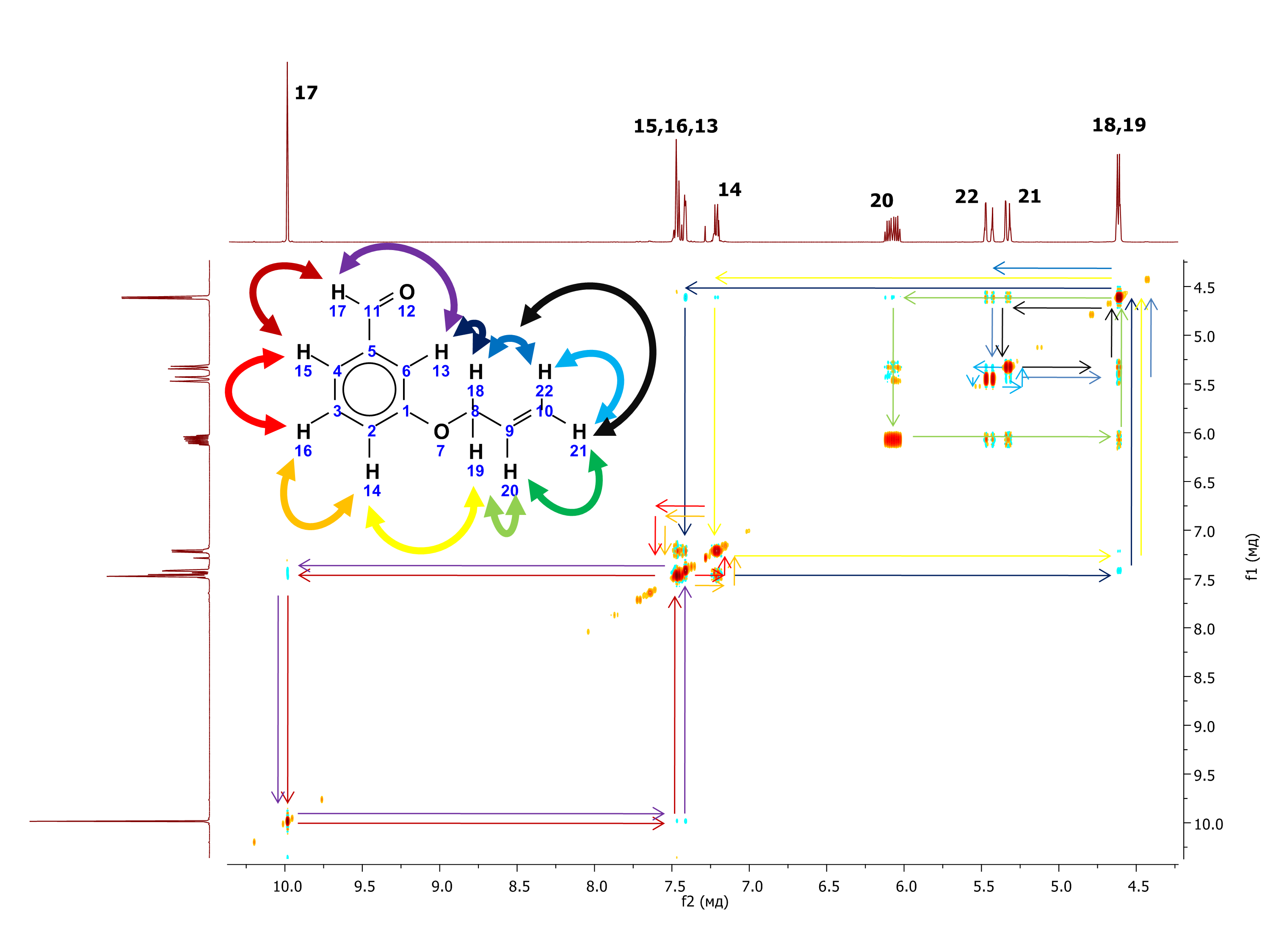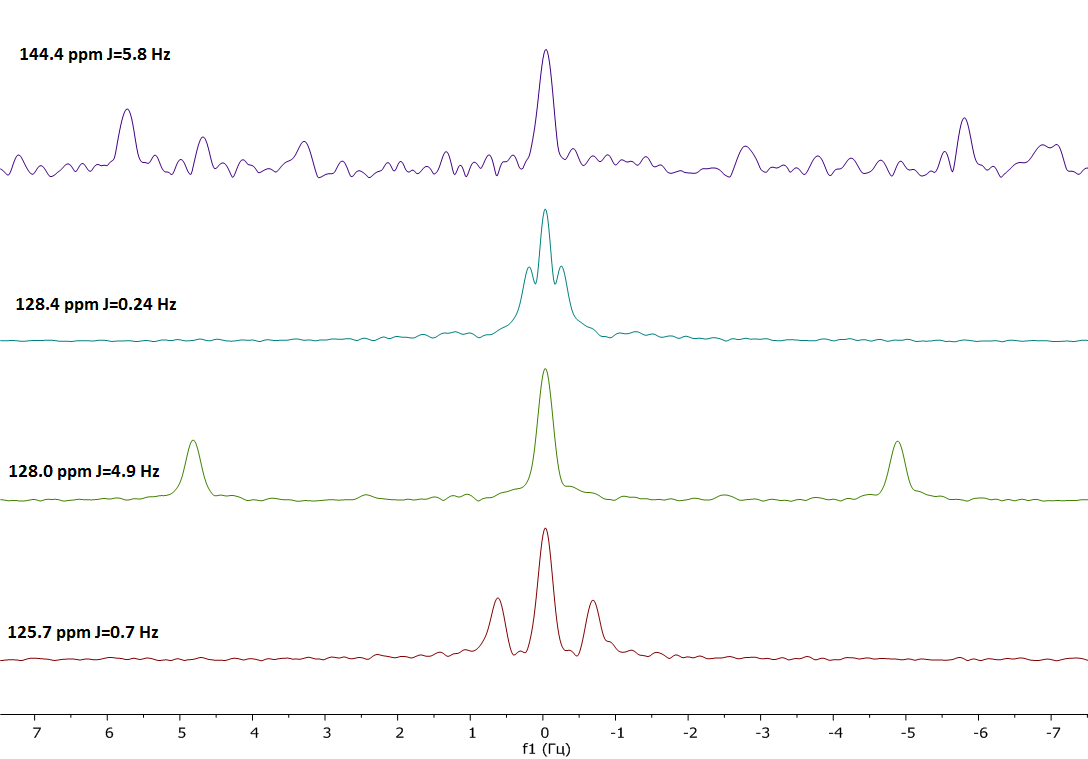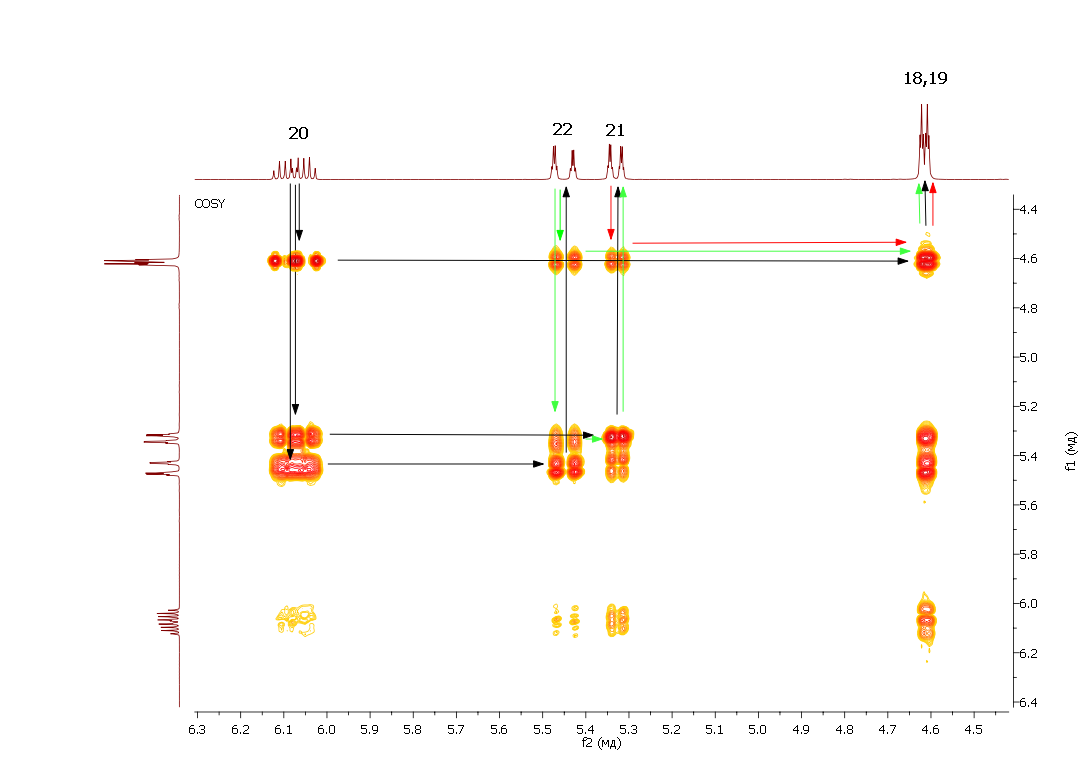JRES
Allows one to separate coupling constants and chemical shifts, simplifying the analysis of multiplet structure of the signals in case if they overlap in 1D NMR spectrum.
References:
1. W.P. Aue, J. Karhan, R.R. Ernst, J. Chem. Phys., 1976, 64, 4226-4227.
2. T.D.W. Claridge, "High-resolution NMR techniques in Organic Chemistry", 2nd ed., Elsevier, 2009.
3. R. Freeman, A Handbook of NMR, Longman, 1987, 106-110.
4. D.D. Traficante, M.D. Meadows, Concepts Magn. Reson., 1997, 9, 359-384.
5. P. Mutzenhardt, F. Guenneau, D. Canet, J. Magn. Reson., 1999, 141, 312-321.
6. M. Ochs, S. Berger, Magn. Reson. Chem., 1990, 28, 994-997.
Selective JRES
This method allows one to obtain the values of coupling constants between X-nuclei with a particular group of protons. As an example let us consider the carbon spectrum of ethylbenzene with the proton decoupling:
Let us now assume that we are interested in couplings between aromatic carbon atoms with methylene protons. It is relatively complicated to obtain this information from the spectrum given above, due to the presence of several coupling constants. Selective JRES spectrum simplifies this significantly:
2. COSY, COSYDQF, long-range COSY
Correlation for protons linked by a spin-spin coupling constant.
COSY
References:
1. J. Jeener, Ampere International Summer School, Basco Polje, 1971 (proposal).
2. W.P. Aue, E. Bartholdi, R.R. Ernst, J. Chem. Phys., 1975, 64, 2229-2246.
3. U. Piantini, O.W. Sorencen, R.R. Ernst, J. Am. Chem. Soc., 1982, 104, 6800-6801.
4. M. Rance, O.W. Sorencen, G. Bodenhausen, G. Wagner, R.R. Ernst, K. Wuthrich, Biochem. Biophys. Res. Commun., 1983, 117, 479-485.
5. A.E. Derome, M.P. Williamson, J. Magn. Reson., 1990, 88, 177-185.
6. A. Bax, R. Freeman, J. Magn. Reson., 1981, 44, 542-561.
7. T.D.W. Claridge, "High-resolution NMR techniques in Organic Chemistry", 2nd ed., Elsevier, 2009.
Long-Range COSY
This method allows one to observe spin-spin interactions with coupling constant below 1 Hz. In the example given above one can see the interaction between the aldehyde proton (17) and methylene protons (18,19) with benzene ring protons.
References:
1. J. Jeener, Ampere International Summer School, Basco Polje, 1971 (proposal).
2. W.P. Aue, E. Bartholdi, R.R. Ernst, J. Chem. Phys., 1975, 64, 2229-2246.
3. U. Piantini, O.W. Sorencen, R.R. Ernst, J. Am. Chem. Soc., 1982, 104, 6800-6801.
4. M. Rance, O.W. Sorencen, G. Bodenhausen, G. Wagner, R.R. Ernst, K. Wuthrich, Biochem. Biophys. Res. Commun., 1983, 117, 479-485.
5. A.E. Derome, M.P. Williamson, J. Magn. Reson., 1990, 88, 177-185.
6. A. Bax, R. Freeman, J. Magn. Reson., 1981, 44, 542-561.
7. T.D.W. Claridge, "High-resolution NMR techniques in Organic Chemistry", 2nd ed., Elsevier, 2009.
3. NOESY
Correlation for protons closely located in space.

1. J. Jeener, B.H. Meier, P. Bachmann, R.R. Ernst, J. Chem. Phys., 1979, 71, 4546-4553.
2. D.J. States, R.A. Haberkorn, D.J. Ruben, J. Magn. Reson., 1982, 48, 286-292.
3. G. Bodenhausen, H. Kogler, R.R. Ernst, J. Magn. Reson., 1984, 58, 370-388.
4. D. Neuhaus, M.P. Williamson, "The Nuclear Overhauser Effect in Structural and Conformation Analysis", 2nd ed., Wiley-VCH, 2000.
4. HXCORR, HMQC, HSQC
Correlation for protons directly linked with X nucleus (usually X = 13C).
HXCORR

References:
1. R. Freeman, G.A. Morris, J. Chem. Soc. Chem. Commun., 1978, 684-686.
2. A. Bax, G.A. Morris, J. Magn. Reson., 1981, 42, 501-505.
3. G.E. Martin, A.S. Zektzer, "Two-Dimentional NMR Methods for Establishing Molecular Connectivity", VCH, 1988, 162-192.
HMQC
HMQC (Heteronuclear Multiple Quantum Coherence) is a correlation between chemical shifts of protons and chemical shifts of X nuclei (usually X = 13C or 15N) through the direct spin-spin interactions (1J) between said nuclei. The detected nuclei in this method are protons, which allows one to significantly shorten the experiment time in comparison with the "traditional" HXCORR, due to the higher proton sensitivity.
References:
1. L. Muller, J. Am. Chem. Soc., 1979, 101, 4481-4484.
2. A. Bax, R.H. Griffey, B.L. Hawkins, J. Magn. Reson., 1983, 55, 301-315.
3. G.E. Martin, A.S. Zektzer, "Two-Dimentional NMR Methods for Establishing Molecular Connectivity", VCH, 1988, 213-221.
4. W.F. Reynolds, R.G. Enriquez, Magn. Reson. Chem., 2001, 39, 531-538.
HSQC
HSQC (Heteronuclear Single Quantum Coherence) is similar to HMQC (see the corresponding section), but in contrast to it, HSQC allows one to reach higher resolution in X-nucleus axis, being however more demanding to the setup of the experiment.
References:
1. G. Bodenhausen, D.J. Ruben, Chem. Phys. Lett., 1980, 69, 185-189.
5. COLOC, HMBC
Correlation for protons and X nuclei through several bonds (usually X = 13C).
COLOC
COLOC (COrrelation of LOng range Coupling) is a correlation between proton and X nuclei (most often 13C or 15N), which are separated by two or three (in rare occasions even more) bonds. In this method the detected nucleus is X, which leads to the necessity of long acquisitions. Because of this, nowadays the more often inverse HMBC method is used, allowing one to obtain the same type of information much faster.
References:
1. H. Kessler, C. Griesinger, J. Zarbock, H.R. Loosli, J. Magn. Reson., 1984, 57, 331-336.
2. H. Kessler, C. Griesinger, K. Wagner, J. Am. Chem. Soc., 1987, 109, 6927-6933.
3. G.E. Martin, A.S. Zektzer, "Two-Dimentional NMR Methods for Establishing Molecular Connectivity", VCH, 1988, 255-267.
HMBC
HMBC (Heteronuclear Multiple Bond Correlation) is a correlation between proton and X nuclei (most often 13C or 15N), which are separated by two or three (in rare occasions even more) bonds. . In this method the detected nuclei are protons, which leads to much shorter experiment time comparing to the duration of the COLOC experiment. In order to distinguish between the interactions via two and three bonds one has to use special modifications of this method.
References:
1. A. Bax, M.F. Summers, J. Am. Chem. Soc., 1986, 108, 2093-2094.
2. G.E. Martin, A.S. Zektzer, “Two-Dimentional NMR Methods for Establishing Molecular Connectivity”, VCH, 1988, 267-273.
3. W.F. Reynolds, R.G. Enriquez, Magn. Reson. Chem., 2001, 39, 531-538.
6. 2D INADEQUATE
Correlation for directly bound 13С nuclei. Due to very low sensitivity this method required high concentration of the sample.
2D INADEQUATE (Incredible Natural Abundance DoubleQuantum Transfer Experiment) potentially is the most powerful method for the analysis of the carbon skeleton of a molecule, which is based on the information about the directly bound carbon atoms. However, the low sensitivity of the methods requires high concentration of the sample and extremely long acquisition times. Due to this reasons 2D INADEQUATE is rarely used in practice.
References:
1. A. Bax, R. Freeman, T.A. Frenkeil, J. Am. Soc., 1981, 103, 2102-2104.
2. W.E. Hull, in: W.R. Croasmun, R.M.K. Carlson (eds.), "Two-Dimensional NMR Spectroscopy", VCH, 1994, 353-356.
3. D.L. Mattiello, R.Freeman, J. Magn. Reson., 1998, 135, 514-521.
4. M. Bourdonneau, B. Ancian, J. Magn. Reson., 1998, 132, 316-327.
5. J. Bunkenborg, N.C. Nielsen, O.W. Sorensen, Magn. Reson. Chem., 2000, 38, 58-61.
6. J. Buddrus, J. Lambert, Magn. Reson. Chem., 2002, 40, 3-23.









